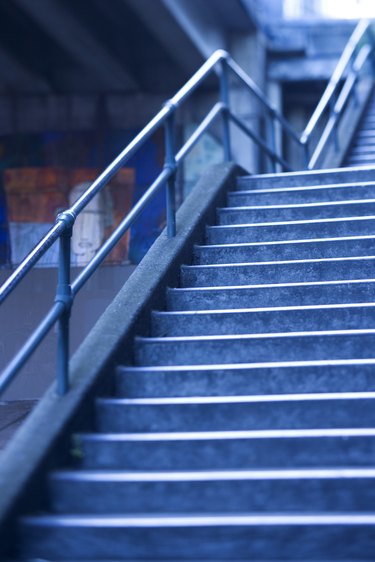 Minimum tread depth is just one of the standards that stairs must follow to be usable. Image Credit: Thinkstock/Comstock/Getty Images
Minimum tread depth is just one of the standards that stairs must follow to be usable. Image Credit: Thinkstock/Comstock/Getty Images
Though complex to build, stairs remain the most convenient and cost-effective way for people to travel between floors. Stairs require careful construction and adherence to standards, so they remain sturdy and safe enough for many people to use every day. Such standards define minimum stair tread depth, as well as other dimensions. The stair treads are the steps that people walk on to climb up or down a stairway.
Video of the Day
Who Sets the Code
The International Code Council, a member association, helps governments and communities define construction codes that set minimum safety standards in homes, schools and workplaces. Its International Building Code, or IBC, is either followed directly or adopted with some modifications by state and local building organizations. Stair treads must follow constant measurements to prevent falls and work consistently with other stair standards such as riser height.
Standards
According to the IBC, stair tread depths must be a minimum of 11 inches on rectangular stairs. The tread depth can go to any maximum, as long as the maximum tread in a stairway does not exceed the smallest by over 0.375 inches. The riser height, which is the distance between the leading edges of treads following each other, must be a minimum of four inches and a maximum of seven inches. The variation between riser heights must not be over 0.375 inches. Stairways that do not follow these standards risk unsafe falls and stumbles for their users.
Winders
Winders are stairs that change direction, such as around a corner, producing irregularly shaped treads. The minimum general tread depth remains 11 inches, but it is measured at a right angle from the leading tread edge that is 12 inches from the narrowest side. This narrow side must have a minimum tread depth of 10 inches. The greatest depth at the 12-inch mark must not exceed the smallest on any other tread by more than 0.375 inches.
Disabilities
The American Disability Accessibility Guidelines also define minimum standards for stairs that the handicapped can use. In general, these are the same as IBC standards, such as specifying a minimum tread depth of 11 inches, with uniformity among all treads, and minimum risers of between four and seven inches, with uniformity among all risers.
Local Exceptions
As an example of local modifications, the building codes for Portland, Oregon, generally follow the IBC for stair specifications with some changes. The city defines minimum tread depths at nine inches, with the nosing (the exposed part of the tread) measuring between 0.75 inches and 1.25 inches. Minimum riser height is eight inches. Variations between tread depths and riser heights must be no more than 0.375 inches. Winder stairs must have a minimum of nine inches at the 12-inch mark, with a minimum width of six inches at the narrowest edge.


